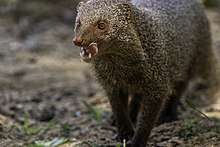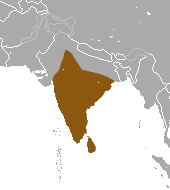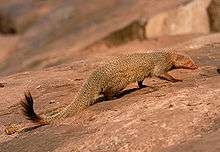Ruddy mongoose
| Ruddy mongoose | |
|---|---|
 | |
| Ruddy mongoose, Yala National Park, Sri Lanka | |
| Scientific classification | |
| Kingdom: | Animalia |
| Phylum: | Chordata |
| Class: | Mammalia |
| Order: | Carnivora |
| Family: | Herpestidae |
| Subfamily: | Herpestinae |
| Genus: | Herpestes |
| Species: | H. smithii |
| Binomial name | |
| Herpestes smithii Gray, 1837 | |
 | |
| Ruddy mongoose range | |
The ruddy mongoose (Herpestes smithii) is a species of mongoose found in hill forests of peninsular India and Sri Lanka. This mongoose, along with the striped-neck and Indian grey mongeese, are the only mongoose species endemic to India and Sri Lanka. The ruddy mongoose is very closely related to Indian grey mongoose, but distinguished by its slightly larger size and black-tipped tail extending for 2 to 3 inches at the distal end. There are two sub-species of this mongoose, H. smithii smithii in India, and H. smithii zeylanicus (Thomas, 1852) in Sri Lanka.[1][2]


Habitat
The ruddy mongoose is mainly a forest-living animal, in contrast to the grey and small Indian mongooses and prefers more secluded areas. They have also been recorded from secluded paddy fields and in comparatively open fields.[3]
Subspecies
- H. smithii smithii
- H. s. thysanurus
- H. s. zeylanius
Ecology
Like other mongooses, it hunts by day and by night.[3]
In Culture
In Sri Lanka this animal is called mugatiya by the Sinhala speaking community. Usually regarded as an unlikable animal and a pest. The golden palm civet (Paradoxurus zeylonensis), altogether a different species endemic to Sri Lanka, is also called hotambuwa due to similar appearance and coloration.
See also
References
- ↑ Choudhury, A., Wozencraft, C., Muddapa, D. & Yonzon, P. 2008. Herpestes smithii. In: IUCN 2008. 2008 IUCN Red List of Threatened Species. www.iucnredlist.org. Downloaded on 27 January 2009.
- ↑ http://www.wii.gov.in/envis/envisdec99/ruddymongoose.htm
- 1 2 ISBN 019562169-7 The Book of Indian Animals, SH Prater, 3rd ed
| Wikispecies has information related to Herpestes smithii |
